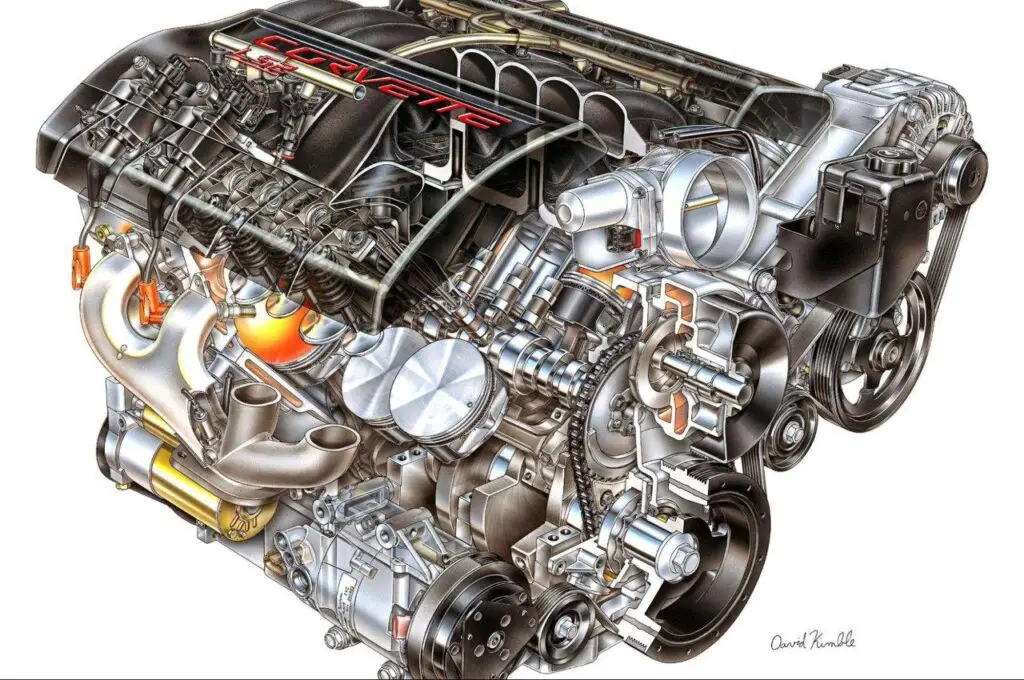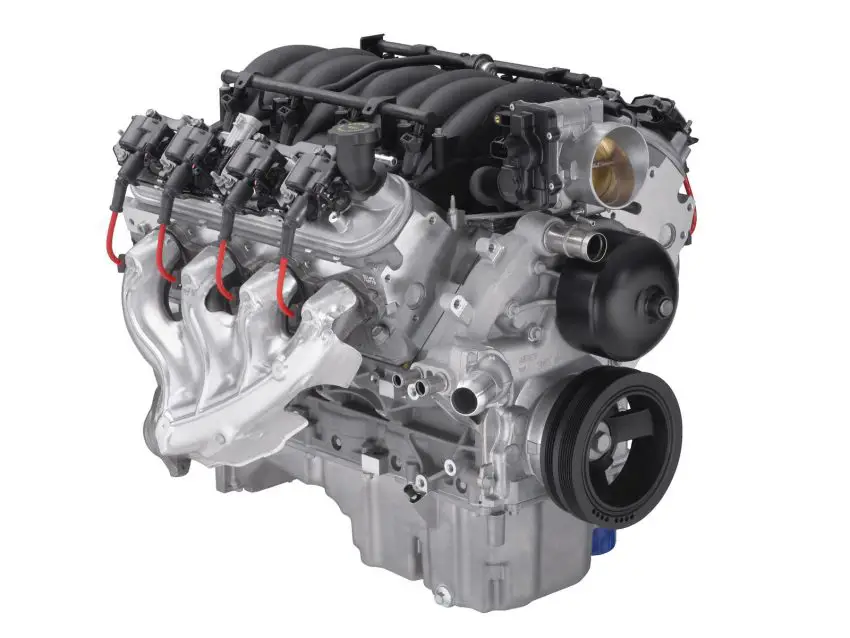The LS1 engine is a 5.7-liter V8 introduced by GM in 1997, featuring an aluminum block and heads for a lightweight design. It produces 345 horsepower and 350 lb-ft of torque in stock form, with a compression ratio of 10.1:1. Known for its tunability, the LS1 is popular for its high-revving capability, strong low-end torque, and extensive aftermarket support.
The LS1 engine is one of the most legendary powerplants ever produced by General Motors (GM), earning its place as the foundation of the modern LS engine family. Introduced in 1997 as the heart of the fifth-generation Chevrolet Corvette (C5) and later used in various other GM vehicles, the LS1 is revered for its lightweight design, impressive performance, and immense tuning potential.
In this article, we’ll dive deep into the LS1 engine specs, its technical details, performance characteristics, and modifications, as well as answer some frequently asked questions.

Contents
History and Overview of the LS1 Engine
The LS1 marked the beginning of GM’s “Gen III” small-block engine series, designed to replace the aging LT1 and its predecessors. With the LS1, GM sought to improve power output, efficiency, and reliability while maintaining the compact dimensions of the previous small-block V8s. The engine debuted in the 1997 Corvette, producing 345 horsepower, and quickly became a favorite among car enthusiasts and tuners due to its robust design and performance capabilities.
LS1 Engine Specs
To understand why the LS1 is so highly regarded, it’s essential to examine its key specifications, which set it apart from earlier small-block engines.
Engine Type and Configuration
- Engine Type: Naturally aspirated V8
- Displacement: 5.7 liters (346 cubic inches)
- Bore x Stroke: 3.898 inches x 3.622 inches (99.00 mm x 92.00 mm)
- Compression Ratio: 10.1:1
- Valvetrain: Overhead valve (OHV), 2 valves per cylinder (16 total)
- Fuel System: Multi-port fuel injection
The LS1 features an aluminum block and heads, a significant upgrade from the traditional cast-iron blocks of earlier GM small-block engines. The aluminum construction reduces weight while improving heat dissipation, contributing to the engine’s efficiency and performance.
Power and Torque
- Horsepower (Stock): 345 hp @ 5,600 RPM (in the Corvette C5)
- Torque (Stock): 350 lb-ft @ 4,400 RPM
These power figures helped set new performance benchmarks for the Corvette in the late 1990s and made the LS1 an attractive option for a range of other GM vehicles, such as the Pontiac Firebird Trans Am and Chevrolet Camaro Z28.
Cylinder Block and Crankshaft
- Block Material: Aluminum with cast-iron cylinder liners
- Crankshaft Material: Nodular iron
- Main Bearing Caps: 6-bolt mains
The LS1’s use of a lightweight aluminum block with cast-iron cylinder liners significantly reduces engine weight compared to previous generations of small-block V8s. The 6-bolt main bearing caps increase block rigidity, allowing the engine to handle higher power outputs and more stress without failure.
Cylinder Heads
- Head Material: Aluminum
- Valves: Steel, with sodium-filled exhaust valves for better heat resistance
- Valve Sizes: Intake valves are 2.00 inches (50.8 mm) in diameter, and exhaust valves are 1.55 inches (39.37 mm)
The cylinder heads on the LS1 are designed for better airflow, contributing to its higher power output. The use of aluminum further aids in reducing weight while enhancing cooling efficiency.
Camshaft
- Camshaft Material: Billet steel
- Camshaft Specs: Stock camshaft lift is 0.500 inches for both intake and exhaust
- Duration: 202 degrees intake and 210 degrees exhaust at 0.050-inch lift
The camshaft design offers a balance between low-end torque and high-end power, making the LS1 a versatile engine for both daily driving and high-performance applications.
Ignition and Fuel System
- Ignition Type: Coil-on-plug ignition
- Fuel System: Sequential multi-port fuel injection (SFI)
- Fuel Injector Size: 26 lb/hr
The coil-on-plug ignition system improves spark energy and timing accuracy, enhancing combustion efficiency and power delivery. The multi-port fuel injection system ensures precise fuel delivery to each cylinder, optimizing performance and fuel economy.
Performance Characteristics of the LS1 Engine
The LS1 engine is known for its blend of power, durability, and responsiveness. Here are some key performance highlights:
1. Lightweight and Efficient Design
The LS1’s all-aluminum construction provides a significant weight advantage over cast-iron block engines, improving vehicle handling and fuel efficiency. The engine weighs roughly 430 pounds, which is light for a V8 of its size and output.
2. High Revving Capability
With a redline of 6,200 RPM, the LS1 is known for its willingness to rev, providing a broad powerband that delivers strong acceleration across a wide RPM range. This characteristic makes the engine well-suited for both track use and spirited driving.
3. Strong Low-End Torque
The LS1 delivers ample low-end torque, making it responsive and powerful at lower RPMs, ideal for street driving. The engine’s peak torque of 350 lb-ft is available relatively low in the rev range, enhancing acceleration from a standstill or low speeds.
4. Tunability
One of the most appealing aspects of the LS1 engine is its tunability. The LS platform has one of the largest aftermarket support communities, with a wide range of performance upgrades available, including camshaft swaps, cylinder head porting, supercharging, and more. With basic bolt-ons and tuning, the LS1 can easily surpass 400 horsepower, and with forced induction, it can handle even greater power levels.
Applications of the LS1 Engine
While the LS1 is most famously associated with the C5 Corvette, it found its way into a variety of other GM vehicles, including:
- Chevrolet Camaro Z28/SS (1998-2002)
- Pontiac Firebird/Trans Am (1998-2002)
- Holden Commodore (1999-2006) (under the name “LS1”)
The LS1 engine has also become a popular choice for engine swaps in various vehicles, from classic muscle cars to modern sports cars, due to its compact dimensions, lightweight construction, and aftermarket support.
LS1 Modifications and Upgrades
The LS1’s aftermarket potential is immense. Whether you’re looking to boost horsepower or improve reliability, here are some common LS1 modifications:
1. Cold Air Intake and Exhaust: A cold air intake combined with a high-flow exhaust system is one of the easiest ways to increase airflow and, consequently, horsepower. This simple mod can yield gains of 10-20 horsepower.
2. Camshaft Upgrade: A more aggressive camshaft can significantly boost horsepower and torque, particularly in the mid to high RPM range. Camshaft upgrades often require supporting mods like stronger valve springs and pushrods.
3. Cylinder Head Porting: Porting the stock cylinder heads or replacing them with aftermarket heads can drastically improve airflow, resulting in significant power gains. This mod is often paired with a camshaft upgrade for maximum benefit.
4. Forced Induction (Supercharger/Turbocharger): The LS1 is capable of handling forced induction with the proper supporting mods. Superchargers and turbochargers can push power figures well beyond 600 horsepower, though you’ll need to upgrade internal components like pistons and rods to handle the extra stress.
5. ECU Tuning: To fully capitalize on any modifications, tuning the engine control unit (ECU) is essential. Tuning optimizes the air-fuel ratio, ignition timing, and other parameters to ensure the engine runs smoothly with new performance parts.

Frequently Asked Questions
Here are some FAQs about LS1 engine specs –
1. How much horsepower can the stock LS1 handle?
The stock LS1 can handle around 450-500 horsepower with no internal modifications. With upgrades like forged internals and improved cooling, it can safely handle 600+ horsepower, especially with forced induction.
2. What is the difference between the LS1 and LS6 engines?
The LS6, introduced in the C5 Corvette Z06, is an evolution of the LS1. It features a revised intake manifold, better cylinder heads, a more aggressive camshaft, and higher compression, resulting in more horsepower and torque.
3. How reliable is the LS1 engine?
The LS1 is considered a highly reliable engine when properly maintained. With regular oil changes, coolant flushes, and routine inspections, it can easily last over 200,000 miles without significant issues.
4. Can I swap an LS1 into my vehicle?
Yes, the LS1 is a popular engine swap choice due to its compact dimensions, lightweight design, and availability of aftermarket support. It has been swapped into everything from classic muscle cars to modern sports cars.
5. What is the best camshaft for the LS1?
The best camshaft depends on your goals. For street use, a mild cam with increased duration and lift will provide better mid-range power without sacrificing drivability. For racing or high-performance builds, a more aggressive camshaft will provide maximum top-end power but may affect idle quality and low-speed drivability.
Conclusion
The LS1 engine is a cornerstone of GM’s performance legacy, delivering an exceptional balance of power, efficiency, and tunability. Its lightweight design, robust construction, and extensive aftermarket support make it a favorite among car enthusiasts, tuners, and racers alike. Whether you’re keeping it stock or aiming for 1,000 horsepower, the LS1 is a versatile and reliable engine that continues to influence modern automotive performance.